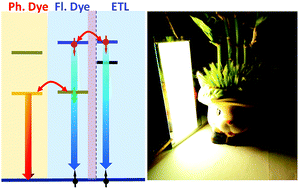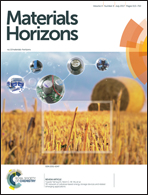Spatial exciton allocation strategy with reduced energy loss for high-efficiency fluorescent/phosphorescent hybrid white organic light-emitting diodes†
Abstract
Due to the poor operational lifetime of blue phosphorescent dopants and blue thermally activated delayed fluorescent (TADF) materials, hybrid white organic light-emitting diodes (WOLEDs) with conventional blue fluorescent emitters are still preferred for commercial applications in general lighting. However, the improvement in the overall efficiency of hybrid WOLEDs has been limited due to energy losses during the energy transfer process and exciton quenching after the spatial separation of the singlet and triplet excitons. Here we demonstrate the development of a Spatial Exciton Allocation Strategy (SEAS) to achieve close to 100% internal quantum efficiency (IQE) in blue-yellow complementary color hybrid WOLEDs. The employed blue fluorophore not only has a resonant triplet level with the yellow phosphor to reduce energy loss during energy transfer processes and triplet–triplet annihilation (TTA), but also has a resonant singlet level with the electron transport layer to extend singlet exciton distribution and enhance both singlet and triplet exciton utilization. The resulting hybrid WOLEDs exhibited 104 lm W−1 efficacy at 100 cd m−2 and 74 lm W−1 at 1000 cd m−2 with CIE coordinates of (0.42, 0.44) which is warm white and suitable for indoor lighting.

- This article is part of the themed collection: Materials Horizons 10th anniversary regional spotlight collection: Africa and the Middle East


 Please wait while we load your content...
Please wait while we load your content...